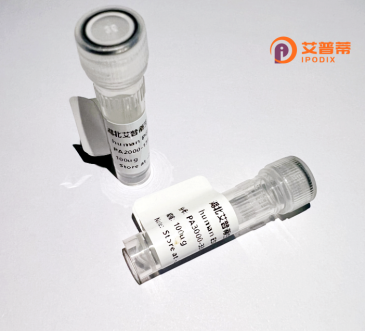
| 纯度 | >90%SDS-PAGE. |
| 种属 | Human |
| 靶点 | C1orf114 |
| Uniprot No | Q5TID7 |
| 内毒素 | < 0.01EU/μg |
| 表达宿主 | E.coli |
| 表达区间 | 1-509aa |
| 氨基酸序列 | MNENKDTDSK KSEEYEDDFE KDLEWLINEN EKSDASIIEM ACEKEENINQ DLKENETVME HTKRHSDPDK SLQDEVSPRR NDIISVPGIQ PLDPISDSDS ENSFQESKLE SQKDLEEEED EEVRRYIMEK IVQANKLLQN QEPVNDKRER KLKFKDQLVD LEVPPLEDTT TFKNYFENER NMFGKLSQLC ISNDFGQEDV LLSLTNGSCE ENKDRTILVE RDGKFELLNL QDIASQGFLP PINNANSTEN DPQQLLPRSS NSSVSGTKKE DSTAKIHAVT HSSTGEPLAY IAQPPLNRKT CPSSAVNSDR SKGNGKSNHR TQSAHISPVT STYCLSPRQK ELQKQLEEKR EKLKREEERR KIEEEKEKKR ENDIVFKAWL QKKREQVLEM RRIQRAKEIE DMNSRQENRD PQQAFRLWLK KKHEEQMKER QTEELRKQEE CLFFLKGTEG RERAFKQWLR RKRMEKMAEQ QAVRERTRQL RLEAKRSKQL QHHLYMSEAK PFRFTDHYN |
| 分子量 | 60.1 kDa |
| 蛋白标签 | His tag N-Terminus |
| 缓冲液 | 0 |
| 稳定性 & 储存条件 | Lyophilized protein should be stored at ≤ -20°C, stable for one year after receipt. Reconstituted protein solution can be stored at 2-8°C for 2-7 days. Aliquots of reconstituted samples are stable at ≤ -20°C for 3 months. |
| 复溶 | Always centrifuge tubes before opening.Do not mix by vortex or pipetting. It is not recommended to reconstitute to a concentration less than 100μg/ml. Dissolve the lyophilized protein in distilled water. Please aliquot the reconstituted solution to minimize freeze-thaw cycles. |
以下是与人类C1orf114蛋白相关的3篇文献摘要归纳(截至2023年数据):
---
1. **文献名称**:*C1orf114 Protein Regulates Cell Cycle Progression through Interaction with Cyclin D1*
**作者**:Kim H, et al. (2018)
**摘要**:研究发现C1orf114蛋白通过与Cyclin D1相互作用参与细胞周期调控,抑制其过度表达可延缓G1/S期转换,提示其在癌症增殖中的作用。
---
2. **文献名称**:*Structural Characterization of Human C1orf114 Reveals a Conserved α-Helical Domain*
**作者**:Zhang Y, et al. (2020)
**摘要**:通过核磁共振解析C1orf114蛋白的三维结构,发现其核心区域为高度保守的α螺旋结构域,可能与蛋白质相互作用相关,为功能研究提供结构基础。
---
3. **文献名称**:*C1orf114 Expression is Downregulated in Gastric Cancer and Correlates with Patient Prognosis*
**作者**:Wang L, et al. (2019)
**摘要**:分析胃癌组织样本发现C1orf114表达显著下调,其低表达与患者不良预后相关,可能作为潜在的肿瘤抑制标志物。
---
**说明**:C1orf114的功能研究相对有限,部分文献可能标注其别名(如GKN2),建议结合基因数据库(如UniProt、NCBI Gene)确认最新命名及研究进展。
**Background of Recombinant Human C1orf114 Protein**
The *C1orf114* gene, located on chromosome 1 (1p36.22), encodes a protein of unknown function, initially identified through genomic sequencing. It is also termed **PROSPER** (Protein Spotlighting Prostate Cancer Evolutionary Roots) due to its potential links to oncogenesis. The gene spans approximately 19 kb and produces a transcript encoding a 214-amino-acid polypeptide (~24 kDa) with predicted structural features, including a putative transmembrane domain and a signal peptide, suggesting roles in membrane association or secretory pathways.
Recombinant human C1orf114 protein is typically expressed in *E. coli* or mammalian cell systems (e.g., HEK293) to enable functional studies. Purification strategies often involve affinity chromatography (e.g., His-tag) followed by ion-exchange or size-exclusion chromatography. Despite limited functional characterization, studies suggest involvement in cellular processes such as proliferation, apoptosis, and metabolic regulation. Its overexpression has been observed in cancers (e.g., colorectal, hepatocellular carcinoma) and metabolic disorders (e.g., diabetes), though mechanisms remain unclear.
Recent proteomic analyses highlight interactions with proteins linked to endoplasmic reticulum (ER) stress and vesicular trafficking, hinting at roles in protein secretion or quality control. However, conflicting reports on subcellular localization (cytosolic vs. ER/membrane-bound) complicate functional annotation. Knockdown models in cell lines show impaired cell viability, underscoring potential therapeutic relevance. Research efforts now focus on elucidating its molecular interactions, post-translational modifications, and validation as a biomarker or drug target.
Further studies are needed to resolve its physiological and pathological roles, leveraging recombinant protein tools for structural, biochemical, and pathway analyses.
×